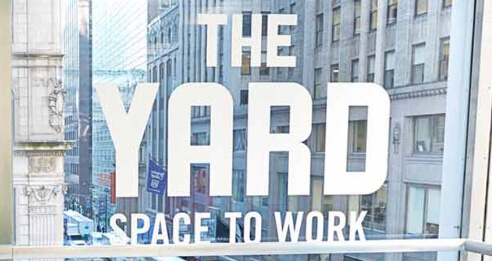
Largest Coworking Companies


Flexibility, agility, and efficiency — are strong pillars of a modern workplace. It may sound surprising, but not all coworking spaces come built with these features. Sometimes you need to additionally mold your workspace into an agile model by introducing design elements that complement them.
An agile coworking space serves the changing needs of the people, providing them with flexible options to choose from and use. It’s an unconventional yet effective workplace setting that caters to the coworking member’s needs and choices.
This model creates a flexible ecosystem for members to enjoy different features, addresses their working needs, and allows them to work where and how they want. Moreover, it will make your coworking space a bit forward and different, providing an edge over competitors.
This article will dig deep into agile workspaces and why a shift from traditional to agile is a need in 2023.
A typical agile workspace strays away from the desk setting and allows residents to work anywhere in the coworking space. This could be comfortable soft seating, a meeting room, or a standing desk.
The idea is to allow members to get into their comfort zones and create a distraction-free environment that enables them to bring their best selves out to work. With fewer restrictions, it enables people to choose where they want to work and when.
The members can work in any part of the working space, which generally has a lot of room to move around and carry out daily activities. They can choose the best setting fit for a particular task.
It strikes a balance between collaboration and privacy, ensuring the workers feel energized and productive in both settings. This ultimately allows the coworking members to move freely and work how they want, without any rigid boundaries.
Traditional workspaces refer to generic coworking spaces where members work at their designated desks, following a routine working pattern. Agile workspaces call for greater flexibility in movement and settings that allow entrepreneurs to work with minimum constraints.
Here are the major differences between the two:
Different elements make up an agile workspace and allow the members to work with flexibility and preference. Let’s talk about these essential elements which make the agile model so unique and fit for every coworking space:

These are open-space areas and the pillar of an agile workspace. These are the common places where members can work and engage with each other. Typically, these are for everyday tasks where they can move around, work, and even have discussions with other members in the space.
Open plan areas bring out a sense of shared responsibility as a part of a coworking community because while you work on your tasks, you also need to keep in mind that others work in the same space. It’s like a living room in your house where everyone can interact with each other while carrying out their everyday tasks.
However, you cannot design these spaces for deep work because of the constant commotion. It needs to have a friendly and casual vibe that promotes networking and unrestricted movement.
These spaces are for members who don’t visit the coworking space often and only want to access spaces for 1-2 hours for brief work. These people come to workspaces less frequently than others but may require working in a distraction-free zone for a short period.
Touchdown spaces mostly have a comfortable sitting area, internet connection, charging points, maybe a few bar tables, and a noise-free boundary wall. These allow visiting members to work effectively whenever they’re around, even if it’s for a few calls or emails. It’s called ‘touchdown’ because people don’t work for long hours in this space, and so it’s only supposed to be designed for short hours of working.
These spaces are generally used for conducting brief meetings and one-on-one discussions. It allows for easy communication and quick work.
These spaces are perfect for breaking out of the conventional workplace setting and moving into a more casual and chill vibe. These are most suitable for short breaks, water cooler conversations with other members, impromptu team meetings, and brainstorming sessions.
These can be designed in a living room style or a game room look and feel to allow members to delve into the calmness that this space offers. It enables greater and more effective collaboration with team members, and the casual vibe allows a free flow of ideas and discussions. This is a more informal space in the coworking area and is not fit for serious discussions, concentrated work, and meetings.
For this reason, the colors and seating arrangement in this area are designed to give out a cooling effect that can empower creative problem-solving and spontaneous ideas.
These are individual spaces in the office meant for work that requires deep concentration and analytical thinking. Quiet zones allow employees to work not in isolation but in a separate place where they can work on concentration-heavy tasks such as writing, taking one-on-one calls, or scheduling in-person meetings.
These zones are either created in a soundproof area with facilities fit for an individual to work quietly or in a separate area in the coworking space, away from the main hustle-bustle. While breakout areas are meant for light teamwork, quiet zones are for essential tasks and video meetings.
Being a private zone area, members can comfortably carry out prolonged tasks in a distraction-free environment with amenities like a desk, chair, charging point, and internet connection.
Every coworking space needs an area accessible to everyone, where resources are readily available and stationed in one place. These include but are not limited to a file safe, printer, scanner, stationary shelf, coffee machine, etc.
These are mostly separate areas and can be situated in multiple places for easy accessibility. It’s a no-brainer and a crucial aspect of any workspace. However, they should be kept separate and have a partition to avoid cluttering and disturbance.
An agile coworking space will allow you to host highly productive teams and members by offering them a range of options. It’s an excellent way of working, where businesses can achieve significant results quickly in a flexible work environment while you cater to the working needs of the members.
It’s important to transition from a traditional to an agile coworking space because of these reasons:

Now that you know how crucial agile coworking spaces are and how a transition can benefit you, here’s how you can make a move.
Before converting your coworking space into an agile model, you must ensure everyone is on board with the idea and understand its depth. There should be no discrepancies in the concept so that you can create a fully functioning agile workplace.
Brainstorm with your team, and see how everyone comes up with ideas to convert the space and make it more flexible. The more hands-on and involved your coworking team is in the transition phase, the easier it will be to execute the plan and succeed at it.
No flexibility is possible without technology. If your members still have to come to the front desk to book a meeting room or pay for a membership or can’t open your door with a smartphone early in the morning or late at night without waking up the administrator, you need to fix this as soon as possible.
The agile workspace concept is about the best user experience, increased productivity, and freedom, which can be easily reached with a coworking app.
The essence of such a coworking space system is that you manage the community and workspace, keeping everything in control while members don’t notice any rigid guidance. They get everything they need through the app on their phone. This includes access to the building, bookings, payments, benefits, services, events, communication, and whatnot. Any service they wish is available with a tap. No asking or calling a manager, no waiting time, no inconveniences.
Also, QR Code gateways could be provided to temporary visitors so that it's easier for them to scan and get all the necessary services. The best QR code generator for a coworking space will enable you to get analytics into how many people scanned and what services they used.
A pleasant bonus of adopting the right coworking space technology is that since members open doors, book their desks, apply for events, and even print with the help of an app, you don’t have to take care of all these business processes. They are fully automated.
The core pillar of an agile coworking space is flexibility. So, you must have multiple options for both individual and group tasks, gatherings and interactions, and concentration areas. All those activities may be planned or unplanned.
Allocate spaces suitable for specific tasks so members have a wide range of options to choose from and work. Not all of these zones should be fixed. Don’t set the roles of your premises in stone as the stone is not agile.
For instance, you can use curtains and acoustic screens instead of walls for visual and acoustic zoning. Choose moveable smart furniture, tiered seating, lightweight stools, and modular huddle pods that can be combined or separated to better suit your new workspace concept.
The main objective of your coworking space is to promise flexibility while staying true to the core values of the agile working space and offering diverse settings to your community.
Your members can highlight the pain points of working in a traditional space, and you can address those in the agile space for your members. This is the best way to ensure you design the workplace by addressing common concerns.
Don’t take these opinions lightly because they can act as a bridge between an average and authentic agile working space.
Embrace a culture of flexibility if you want to make a complete transition into an agile workspace and make your coworking space a part of the agile working ecosystem. There are plenty of different types of coworking spaces, but the agile model is the perfect way to accommodate both productivity and an inclusive working culture.
Remember that the key ingredient of an agile workspace is a huddle. Its main goal is to cater to neuro-inclusivity, providing all members with their unique mindsets with sanctuary spaces for deep work and engagement. These days, interactions between coworkers are valuable as never before as they spark collaboration inside the teams and help them deliver outstanding results faster.
So, ditch the traditional workspace, adopt modern technology along with smart furniture, and design an agile model using this guide that goes beyond fascinating interiors and addresses a transitional shift in working culture.
Save your community manager 41 hours each week—learn how The Yard did it with cloud-based access control.
Read the Case StudyFree access to our best guides, industry insights and more.
